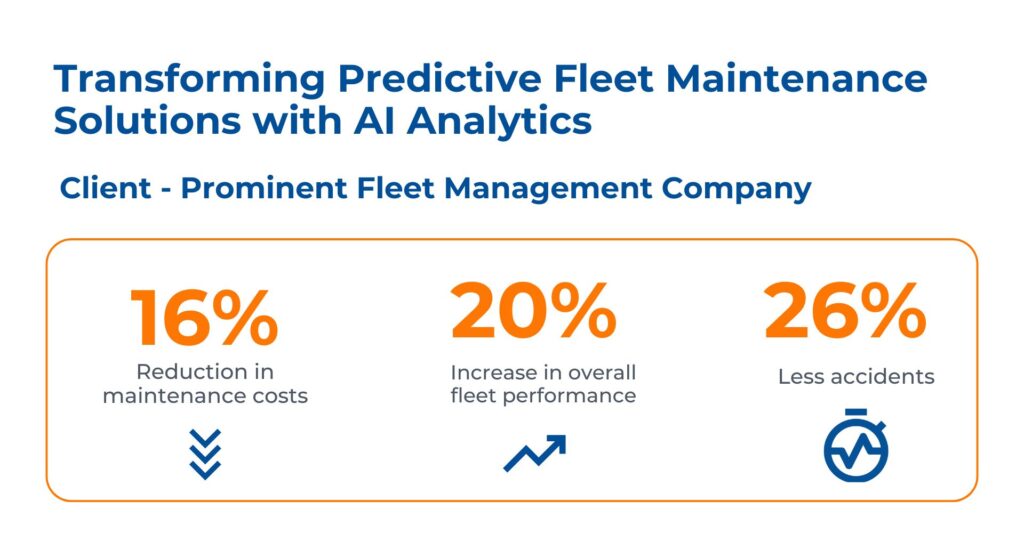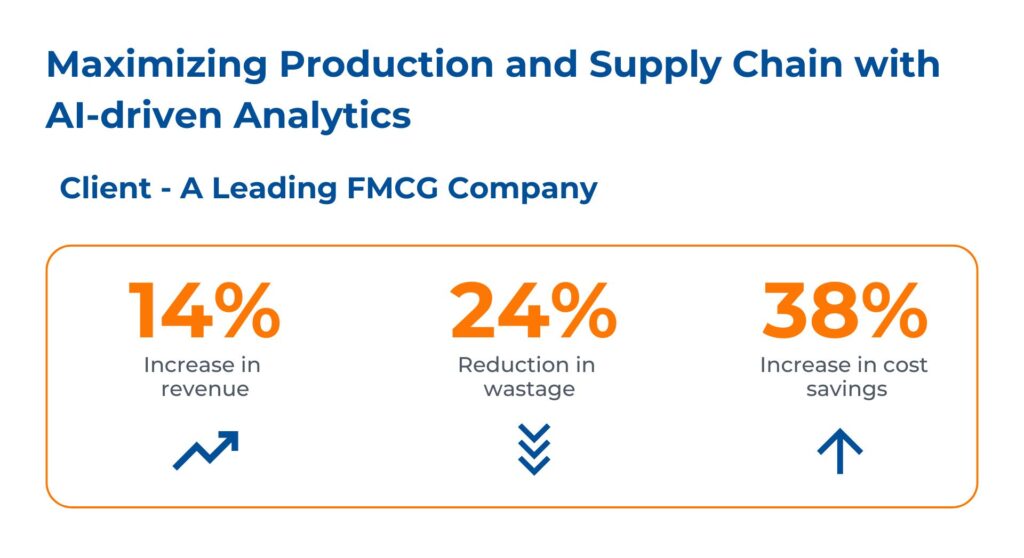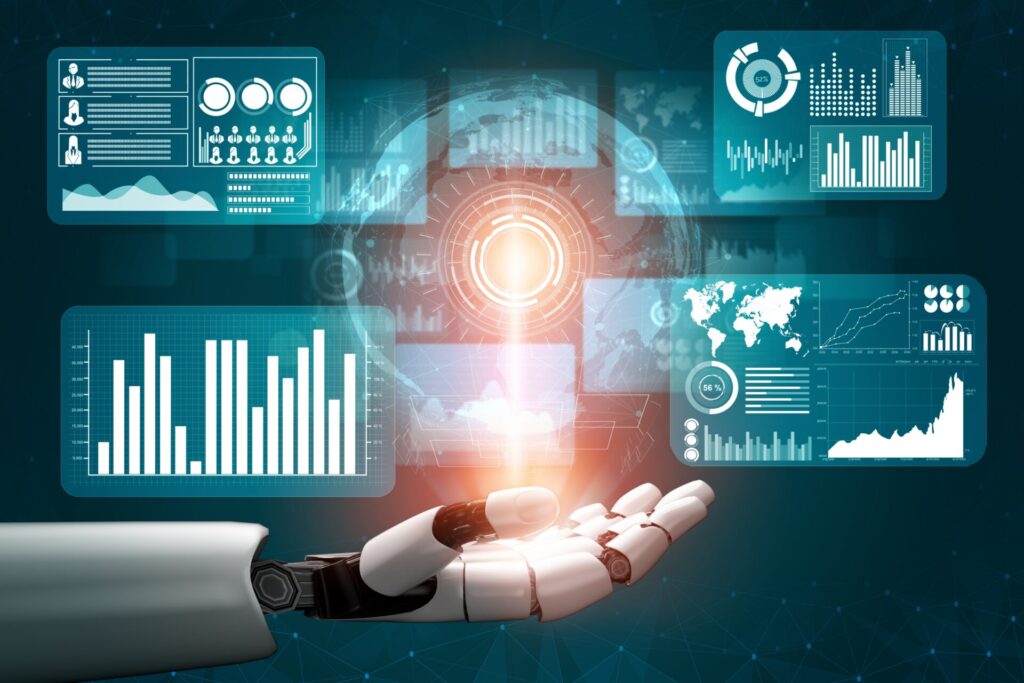Have you ever thought how top retail companies predict shopping trends before they happen, ensuring shelves are stocked with exactly what customers will be seeking next month? The answer lies in augmented analytics. This approach uses artificial intelligence to analyze vast amounts of sales data and social media trends, allowing companies to foresee and react to consumer demand in real-time.
Augmented analytics represents a significant evolution in data processing, turning traditional analytics on its head. Instead of relying solely on historical data and human intuition, businesses can now leverage automated algorithms that sift through and make sense of data at a scale and speed impossible for human analysts.
This transformative approach not only optimizes inventory management but also enhances customer satisfaction by predicting what they desire before they even ask for it. Let’s delve into how augmented analytics is reshaping industries by providing deeper insights and foresight into market dynamics.
What is Augmented Analytics?
Augmented analytics is an approach that uses machine learning and artificial intelligence to enhance data analytics processes. It automates the generation of insights, making it easier and faster for businesses to understand and act on their data. By integrating augmented analytics, companies can efficiently sift through large datasets, identify patterns, and predict trends without needing extensive statistical expertise.
This technology not only speeds up the decision-making process but also improves accuracy by reducing human bias and error, thereby empowering organizations to make more data-driven decisions in real-time.

Technologies Driving Augmented Analytics
Augmented analytics leverages the power of artificial intelligence (AI) and machine learning (ML) to transform data analysis. Let’s check out how these technologies play a crucial role:
Artificial Intelligence (AI): Automating Data Insights
Automating Tedious Tasks
Artificial intelligence (AI) can automate repetitive processes such as data processing, cleansing, and standardization. As a result, human analysts have more time to devote to strategic interpretation and analysis.
Pattern Recognition and Anomaly Detection
Artificial intelligence is particularly good at finding intricate patterns and abnormalities in data that humans would overlook. In doing so, possible issues or opportunities can be identified early on.
Natural Language Processing (NLP)
Natural language processing, or NLP, is a branch of artificial intelligence that allows people to communicate with data using natural language queries. Users can ask questions such as “What are the factors driving customer churn?” and receive answers in plain English instead of having to deal with sophisticated coding.
Automated Data Storytelling
AI can automatically generate reports and visualizations that highlight key trends and insights. This allows for faster communication and dissemination of valuable information to stakeholders.

Machine Learning (ML): Predictive Analysis and Trend Identification
Predictive Modeling
Machine learning algorithms use past data to find trends and forecast future directions. This can be used by businesses to estimate sales, anticipate consumer behavior, and pinpoint possible hazards.
Data Segmentation and Clustering
Machine learning is capable of automatically grouping data according to common attributes. This makes it possible to run customized marketing campaigns and provide individualized client service.
Recommender Systems
These systems leverage machine learning (ML) algorithms to make relevant product or service recommendations to users based on their prior behavior and preferences. E-commerce sites and streaming services frequently employ this.
Optimization and Resource Allocation
ML has the potential to optimize both resource allocation and process efficiency. Streamlining the ad spend in marketing campaigns or logistics’ delivery routes.
The Synergy of AI and ML
AI and ML work together in augmented analytics. AI provides the overall framework and capabilities, while ML algorithms handle specific tasks like pattern recognition and prediction. This synergy allows for a more automated, efficient, and insightful data analysis experience.

Case Study: Revolutionizing Predictive Fleet Maintenance with AI Analytics
Business Challenges: A prominent fleet tracking and management company struggled with operational complexities due to influx of complex, real-time vehicle data from partners that affected their reporting and analytics. They approached Kameika to provide a solution to their problem.
By leveraging technologies like AWS, TensorFlow, and Power BI, Kanerika offered the following solutions:
- Built an AI model analyzing sensor data, maintenance records, and driving patterns for predictive maintenance for vehicles
- Deployed mobile app for real-time alerts on vehicle maintenance and driver behavior for preventative measures
- Enabled informed decisions on vehicle replacement and maintenance schedules, achieving fleet management optimization

Features Defining Augmented Analytics
1. Automated Data Preparation
Imagine spending less time wrestling with messy data and more time uncovering valuable insights. Augmented analytics automates tedious tasks like:
Cleaning the Data: Fixing inconsistencies, formatting errors, and removing duplicates.
Data Wrangling: Transforming data into a usable format for analysis.
Integration of Data: Combining data from different sources into a unified dataset.
This frees up data analysts to focus on higher-level tasks like interpreting results and formulating strategies.
2. Smart Data Discovery
Data can hold hidden gems waiting to be unearthed. Augmented analytics utilizes AI to:
Identify Patterns: Analyze complex datasets and discover subtle patterns or relationships that might be missed by human eyes.
Detect Anomalies: Uncover unusual data points that may indicate potential issues or opportunities.
Surface Trends: Identify emerging trends within the data that can inform future decisions.
By surfacing these hidden insights, augmented analytics empowers users to make data-driven decisions with greater confidence.
3. Natural Language Processing (NLP)
Say goodbye to complex queries and cryptic commands. NLP allows users to interact with data in a natural way:
Ask Questions: Simply ask questions about the data in plain English, and the system will use AI to retrieve relevant insights.
Search for Insights: Use keywords or phrases to explore the data and discover hidden relationships.
Simplify Data Exploration: No more learning complex query languages. NLP makes data analysis more accessible to a wider range of users.
This conversational approach breaks down barriers and allows anyone to unlock the power of data.
4. Automated Insights & Recommendations
Don’t just see the data, understand it! Augmented analytics goes beyond raw numbers by:
Generating Insights: ML algorithms analyze the data and automatically generate key findings and conclusions.
Identifying Relationships: Uncover the “why” behind the numbers – the underlying factors influencing trends and patterns.
Suggesting Actions: Based on the insights, the system may offer recommendations for optimizing processes or addressing challenges.
These automated insights empower users to take immediate action and improve decision-making.

5. Predictive Analytics
Don’t just react, predict! Augmented analytics leverages AI and machine learning to:
Forecast Future Trends: Anticipate future outcomes based on historical data and current trends.
Identify Potential Risks: Proactively identify potential problems before they escalate.
Optimize for Future Performance: Make data-driven decisions that optimize performance and achieve desired outcomes.
This ability to predict future scenarios allows businesses to be more proactive and adaptable in a dynamic environment.
6. Data Visualization with Storytelling
A picture is worth a thousand words, and augmented analytics takes it a step further:
Automated Visualization: AI can automatically generate compelling charts, graphs, and other visuals to effectively communicate insights.
Storytelling with Data: Go beyond charts – the system can suggest narratives and explanations to frame the data in context.
Enhanced Communication: Clear visualizations and compelling narratives ensure everyone understands the data’s message.
By transforming data into an engaging story, augmented analytics fosters better communication and collaboration across teams.
7. Explainable AI (XAI)
Trust is key when it comes to AI-generated insights. Augmented analytics incorporates XAI to:
Explain Reasoning: The system can explain the logic behind its recommendations, providing transparency into the decision-making process.
Build Trust: By understanding how the AI arrived at its conclusions, users can feel more confident in its results.
Improve User Adoption: Transparency fosters trust and encourages users to embrace the power of augmented analytics.
8. Data Democratization
Traditionally, data analysis was the domain of specialists. Augmented analytics breaks down these barriers by:
Simplified User Interface: The system offers user-friendly interfaces that are intuitive and accessible to users with varying levels of technical expertise.
Automated Insights: Less reliance on manual analysis allows non-technical users to gain valuable insights from data.
Empowering Business Users: Democratizing data empowers business users to make data-driven decisions within their areas of expertise.

Case Study: Modernizing Predictive Engine with AI in Logistics
Here’s a glimpse of how Kanerika helped resolve the business challenges of a reputed logistics provider by integrating AI in their operations, leading to improved operations and customer satisfaction:
How Can Augmented Analytics Elevate Your Data Game
1. Automating Complex Data Analysis
Augmented analytics uses AI and machine learning to automate data analysis processes, drastically reducing the time and effort required to manipulate complex datasets. This automation allows businesses to quickly generate insights without needing extensive statistical expertise, making data analysis accessible to a wider range of users within an organization.
2. Enhancing Decision-Making Accuracy
By using advanced algorithms, augmented analytics can identify patterns and trends that may not be immediately evident to human analysts. This leads to more accurate predictions and insights, helping organizations make data-driven decisions with higher confidence. According to Gartner, companies that adopt augmented analytics can improve decision-making processes by up to 20%.
3. Increasing Operational Efficiency
Data scientists and analysts can concentrate on more strategic endeavors by automating repetitive data processes, which frees up significant time. As a result, firms are better equipped to react quickly to opportunities and changes in the market. This also increases overall productivity and operational efficiency.
4. Improving Data Accessibility and Usability
The user-friendly interfaces of augmented analytics solutions enable non-technical users to interact with data using natural language queries. Employees at all levels will be able to make accuarte decisions based on data insights as a result of this democratizing data access throughout the company.
5. Personalizing Insights
These tools allow insights to be customized for particular departments and roles within an organization. Sales teams may obtain information on consumer behavior and sales patterns, for instance, while operations teams may receive data on logistics and process efficiency. The most pertinent information is sent to the appropriate individuals thanks to this role-based customization.
6. Enabling Real-Time Analytics
Businesses can receive real-time insights into data processing and analysis using augmented analytics. This ability is critical for sectors like finance, healthcare, and retail that demand quick decisions. In fast-paced settings, real-time analytics help firms remain competitive and flexible.
7. Facilitating Predictive and Prescriptive Analytics
Augmented analytics goes beyond descriptive analytics to improve prescriptive and predictive capabilities. Prescriptive analytics makes recommendations for potential courses of action to accomplish desired results, whereas predictive analytics projects future trends based on historical data. This proactive strategy aids businesses in anticipating future events and planning successful responses.
8. Enhancing Data Governance and Compliance
Through the automation of compliance checks and data management procedures, augmented analytics tools can assist in guaranteeing that data governance policies are followed. This lowers the possibility of data breaches and guarantees that businesses abide by pertinent laws, safeguarding confidential data.
Case Study: Optimizing Production and Supply Chain through AI Implementation
Business Challenges
A leading food production company in the US has faced issues with complex supply chain network, which made production planning and scheduling challenging. Moreover, the company’s production strategy relied heavily on demand forecasting, primarily derived from historical sales data. The volatility in demand has posed a significant challenge, resulting in over/underproduction.
Solutions
By integrating AI and ML into the production planning, Kanerika has offered the following solutions to elevate their forecasting trends:
- Leveraged AI implementation and ML algorithms, factored with weather and seasonal changes, to improve demand accuracy and enhance decision-making
- Utilized AI in production planning to reduce wastages, and maximize revenues
- Integrated an AI based demand forecasting engine with the client’s ERP system, enabling seamless real-time decision-making

How to Implement Augmented Analytics for Your Business
1. Assess Data Readiness
Data Availability and Quality: Evaluate the type and quality of data you have available. Do you possess the necessary data points to address your specific goals? Ensure data is clean, consistent, and readily accessible for seamless analysis.
Data Infrastructure: Consider your current data infrastructure. Can it handle the demands of augmented analytics? Upgrading your data storage and processing capabilities might be necessary to ensure optimal performance.
3. Choose the Right Augmented Analytics Tools
Market Research and Evaluation: Explore the various augmented analytics platforms available. Carefully consider factors like features, scalability, cost, and ease of use. Look for platforms that integrate seamlessly with your existing data infrastructure for efficient data flow.
Proof of Concept: Many platforms offer free trials or demos. Utilize these to test-drive different solutions and determine which one best aligns with your needs and goals.

4. Building Team Capacity
Change Management: Implementing new technology often requires a shift in mindset. Foster a culture of data-driven decision making within your organization. Educate employees on the benefits and functionalities of augmented analytics to ensure adoption and successful utilization.
Upskilling and Training: Provide comprehensive training on how to use the chosen platform and how to effectively interpret the insights generated by augmented analytics. This empowers employees to leverage the technology for strategic decision-making.
5. Develop a Data Governance Framework
Data Security and Privacy: Ensure your augmented analytics platform adheres to all relevant data privacy regulations. Implement robust security measures to protect sensitive information and maintain data integrity.
Data Governance Framework: Establish clear guidelines for data ownership, access, and quality control. This framework is crucial for ensuring the reliability of your insights and responsible data management.
6. Implementation and Continuous Improvement
Phased Approach: Begin by implementing augmented analytics in a specific area with high potential impact. This allows for focused learning and refinement before scaling up to encompass broader organizational objectives.
Monitoring and Iteration: Continuously monitor the performance of your augmented analytics solution. Evaluate the effectiveness of your chosen platform and data strategies in achieving your goals. Be prepared to refine your approach based on results and emerging best practices.

7 Best Augmented Analytics Tools
Tableau is well known for having strong data visualization features. It combines augmented analytics with user-friendly dashboards and visualizations to assist users in finding hidden information. Data exploration and predictive analysis are aided by Tableau’s AI-driven analytics.
Main Features: Visual analytics, data blending, real-time data analysis, integration with various data sources.
With its interactive visualizations and business intelligence features, Power BI is a comprehensive business analytics solution. It provides capabilities including natural language searches and automatic machine learning models, and it uses AI to improve data insights.
Main Features: Real-time dashboards, AI insights, integration with Microsoft ecosystem, natural language Q&A.
Qlik Sense is a data discovery and visualization tool that uses augmented analytics to enable users instantly interact with data and derive insights. To make data analysis easier, it offers automatic insights and recommendations driven by AI.
Main Features: Associative data model, AI-driven insights, interactive visualizations, self-service analytics.
It integrates sophisticated analytics features with powerful data visualization. Users may get insights and make informed decisions by using AI and machine learning to automate data preparation, analysis, and reporting.
Main Features: Automated insights, natural language generation, interactive dashboards, advanced analytics.
IBM Cognos Analytics is a business intelligence platform that incorporates AI to enhance data analysis and visualization. It provides automated data preparation, AI-driven insights, and the ability to interact with data using natural language.
Main Features: AI-driven insights, data preparation, natural language querying, interactive dashboards.
TIBCO Spotfire is an analytics platform that offers powerful data visualization, analytics, and predictive modeling. It uses AI to enhance data discovery and provides real-time insights through interactive dashboards.
Main Features: AI-driven recommendations, real-time analytics, data visualization, predictive analytics.
Looker, part of the Google Cloud platform, is a data exploration and analytics tool that helps businesses understand their data. It uses augmented analytics to automate data analysis and provide actionable insights through customizable dashboards.
Main Features: Data modeling, AI-driven insights, customizable dashboards, integration with Google Cloud services.

The Impact of Augmented Analytics on Various Industries
1. Healthcare
Augmented analytics is transforming operational efficiency and patient care in the healthcare industry. Healthcare professionals may anticipate patient outcomes, tailor treatments, and allocate resources as efficiently as possible by evaluating enormous volumes of medical data. Better patient care and lower expenses are the results of this.
2. Retail
Retailers are streamlining processes and improving customer experiences with augmented analytics. Businesses can better target marketing campaigns, streamline inventory control, and enhance sales tactics by examining the behavior and preferences of their customers. Revenue rises and customer satisfaction levels rise as a result.
3. Finance
Augmented analytics helps the finance sector by improving customer service, fraud detection, and risk management. Better client trust and retention can result from financial institutions’ ability to identify abnormalities in transaction patterns, evaluate credit risks more precisely, and offer individualized financial advise.
4. Manufacturing
Augmented analytics is useful for supply chain optimization, quality assurance, and predictive maintenance in the manufacturing industry. Manufacturers can guarantee product quality, forecast equipment failures, and improve supply chain management to lower operating costs and downtime by evaluating production data.
5. Transportation and Logistics
In logistics and transportation, augmented analytics is streamlining fleet management, demand forecasting, and route planning. In order to provide prompt and affordable transportation services, businesses can evaluate traffic patterns, weather, and delivery schedules to increase efficiency and lower costs.
6. Energy
Augmented analytics is used by the energy sector to optimize energy distribution, forecast energy use, and perform predictive maintenance. Energy firms can lower operating costs, increase supply reliability, and promote sustainable energy projects by analyzing data from several sources.
7. Human Resources
Augmented analytics improves performance management, employee engagement, and talent acquisition in HR. Businesses can estimate employee attrition, find top talent, and put plans in place to increase productivity and happiness by evaluating employee data.

Achieve Business Success with Kanerika’s AI/ML-powered Analytics
At Kanerika, we understand the complexities of data management and the need for innovative solutions to drive business growth. Leveraging our unmatched expertise in AI/ML and data analytics, we offer tailored analytics solutions that address your unique data challenges
By leveraging advanced analytics, we help you stay ahead of the competition and drive better business growth. Our approach combines state-of-the-art technology with industry-leading practices to ensure maximum impact on your operations.
Partner with us today to harness the full potential of AI/ML-driven analytics and experience a transformative journey towards business success. Let us guide you towards data-driven excellence and strategic advantage in today’s dynamic business landscape.
Frequently Asked Questions
What does augmented analytics mean?
Augmented analytics uses artificial intelligence (AI) and machine learning (ML) to automate data analysis, from data preparation to insight generation. It enhances traditional analytics by streamlining complex processes, making data analysis faster and more accessible. This technology helps users discover deeper insights and make more informed decisions without needing extensive technical expertise.
What is the use of augmented analytics?
Augmented analytics can automate data cleaning, preparation, and insight generation. It identifies patterns, predicts trends, and provides actionable recommendations. By leveraging AI and ML, it simplifies data analysis, allowing users to focus on decision-making rather than data processing. This leads to more efficient and effective use of data in business operations.
How is augmented analytics different from traditional business analytics?
Traditional business analytics relies on manual data analysis and interpretation, often requiring significant effort and expertise. Augmented analytics, however, uses AI and ML to automate these tasks, making the process faster and more efficient. This automation enables deeper insights and more accurate predictions, even for users without extensive technical knowledge.
How can augmented analytics transform your organization?
Augmented analytics can revolutionize your organization by automating data preparation and analysis, freeing up time for strategic initiatives. It provides deeper insights and more accurate predictions, leading to better decision-making. This enhances operational efficiency, drives innovation, and gives your organization a competitive edge in the market.
What is an example of augmented analytics in use?
An example of augmented analytics is a retail company using AI-powered tools to analyze customer data. These tools can identify purchasing patterns, predict future trends, and recommend inventory adjustments. This helps the company optimize stock levels, improve customer satisfaction, and increase sales, all through automated, data-driven insights.
What are the benefits of using augmented analytics?
Augmented analytics offers several benefits, including faster data processing, deeper insights, and more accurate predictions. It makes data analysis accessible to non-experts, reduces the need for extensive manual work, and enhances decision-making capabilities. This leads to improved operational efficiency, better strategic planning, and a stronger competitive position.
What does the future hold for augmented analytics?
The future of augmented analytics looks promising, with continued advancements in AI and ML driving further automation and deeper insights. It will become increasingly integral to business operations, enabling more organizations to leverage data effectively. As technology evolves, augmented analytics will offer even more sophisticated tools, transforming how businesses approach data-driven decision-making.